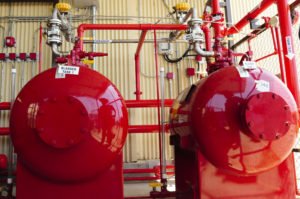Tom Hughes, General Manager at Aerocom, providers of Fire Suppression Systems, AGV machines and pneumatic tube systems for the education, retail and healthcare sectors, explains how different forms of fire suppression systems can control fires that can’t always be put out by water.
A fire can be a terrifying thing, and the destruction it is capable of is unthinkable. That is why it is so important to have systems in place that can tackle a fire quickly and effectively, in order to minimise the risk to life and the damage that it is capable of inflicting.
Fire suppression systems are a collective term for any group of units that are designed to do exactly this using water, foam or chemical compounds. But in an age where new technologies continue to increase concern over general safety, do we need new ways to manage small and large outbreaks of fire?
New technologies causing reason for concern
 There can be many causes of fires, but one of the most common these days is the increased use of lithium batteries. These feature in a number of everyday items in our homes, such as our mobile phones, vapes, laptops, electric bikes, tools and even your electric toothbrush. These batteries are made up of lithium-ion cells, and if one overheats, it can enter a state of thermal runaway which spreads to the other cells.
There can be many causes of fires, but one of the most common these days is the increased use of lithium batteries. These feature in a number of everyday items in our homes, such as our mobile phones, vapes, laptops, electric bikes, tools and even your electric toothbrush. These batteries are made up of lithium-ion cells, and if one overheats, it can enter a state of thermal runaway which spreads to the other cells.
Before you know it, an explosive chemical reaction has occurred, and a fire begins. You might think that incidents like this are still fairly unusual, but they are actually one of the fastest growing causes of fires, and this is largely caused by the process of charging batteries, which is something we all do.
Another big fire risk is the danger of a fire starting in a flat or apartment. This is because so many homes are connected together, and so a fire in one can quickly spread to others, and it becomes much more difficult to control.
After the Grenfell Tower disaster, studies were carried out into the frequency of apartment fires, and they found that there were in the region of 9,000 fires per year in purpose-built flats between 2009 and 2017. This has resulted in between 1000 and 2000 non-fatal casualties per year in that period and tragically, 30-40 fatalities each year.
We can all imagine the devastation that a fire can create, which is why it is so important to do all we can to prevent them. We are used to manual systems like fire extinguishers that require human intervention and therefore risk lives, or sprinkler systems that are often not suitable for the environment. Instead, a fire suppression system works with the space it is in to target fires quickly, effectively and safely.
Fire suppression systems; Better than what we have now?
 Fire suppression systems can tackle fires in a number of different ways. They have a variety of components that work together to deal with a fire as effectively as possible. One of these components is usually some form of detection system that can identify the presence of flames and smoke and then initiate an alarm to try and get people to safety and elicit the quickest response that will hopefully prevent the fire from spreading.
Fire suppression systems can tackle fires in a number of different ways. They have a variety of components that work together to deal with a fire as effectively as possible. One of these components is usually some form of detection system that can identify the presence of flames and smoke and then initiate an alarm to try and get people to safety and elicit the quickest response that will hopefully prevent the fire from spreading.
This ‘active’ method of fire suppression will then include other components which can help to deal with the blaze itself.
Fire suppressions systems have a number of ways of extinguishing smoke and flames, but they do not use water as this is not always effective, depending on the cause of the fire. Gas suppressions systems rely on fire-suppression liquids which have been pressurised with nitrogen and contain a chemical agent called FM200 which can immediately suppress flames. These are popular in areas with a lot of electrical equipment as there is no water involved.
Wet chemical foam systems have been designed especially for use in kitchens as they emit a water-based chemical foam into localised areas and tend to be located underneath canopies of cookers and can be activated through a manual switch or heat link. Water mist systems produce smaller droplets than conventional sprinkler systems creating a layer of steam that can starve the fire of oxygen. These are best suited to spaces that cannot be exposed to large amounts of water.
In the event of a fire, one of the biggest concerns is the presence of flammable liquids, which is why foam deluge systems are also popular. These tend to be installed in refineries, aircraft hangers and industrial warehouses, where fires can accelerate at alarming rates. The system uses a mixture of foam and water to control burning flammable liquids and cool the surface area, whilst the foam starves the blaze of oxygen and inhibits the release of flammable gases.
In some cases, pneumatic heat detection tubes are fitted as a compact and mobile option. A pipe is installed around any potential source of fire and if a particular temperature is reached, it uses a valve to emit a suppressive agent. These are ideal for very small spaces like cupboards, boats and vehicles, but are less suited for areas with high ceilings.
Would your business benefit from better fire protection methods?
Fire suppression systems are extremely popular as they offer more advanced solutions to tackling fires without the need for any human intervention. They prioritise the safety of people nearby, and as they can act immediately, they can minimise any damage that occurs and prevent fires spreading.
For this reason, they have proved to be extremely popular in places such as apartments and holiday parks, as they can stop a fire moving from one dwelling to another. Suppression systems which work in small spaces mean that things such as electric cupboards, fuse boxes, server rooms and switchgears can all be protected, and as the system is activated at a low temperature, the fire is put out before it has a chance to fully take hold.
As they can be used to control fires in large areas and very small spaces, they are now making their way into more and more homes, and are even a big feature of caravan safety. As there does not need to be anyone nearby to tackle the fire, it means that a blaze can be dealt with even if there is no-one in occupancy at the time, therefore potentially saving many lives and thousands of pounds worth of damage.
Fire Safety in 2023 eBook
SHP's sister site, IFSEC Insider has released its annual Fire Safety Report for 2023, keeping you up to date with the biggest news and prosecution stories from around the industry.
Chapters include important updates such as the Fire Safety (England) Regulations 2022 and an overview of the new British Standard for the digital management of fire safety information.
Plus, explore the growing risks of lithium-ion battery fires and hear from experts in disability evacuation and social housing.

 There can be many causes of fires, but one of the most common these days is the
There can be many causes of fires, but one of the most common these days is the  Fire suppression systems can tackle fires in a number of different ways. They have a variety of components that work together to deal with a fire as effectively as possible. One of these components is usually some form of detection system that can identify the presence of flames and smoke and then initiate an alarm to try and get people to safety and elicit the quickest response that will hopefully prevent the fire from spreading.
Fire suppression systems can tackle fires in a number of different ways. They have a variety of components that work together to deal with a fire as effectively as possible. One of these components is usually some form of detection system that can identify the presence of flames and smoke and then initiate an alarm to try and get people to safety and elicit the quickest response that will hopefully prevent the fire from spreading.